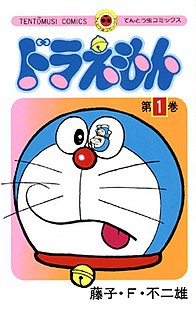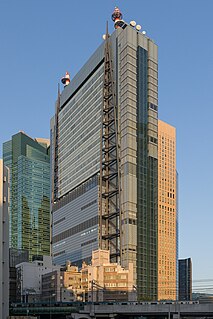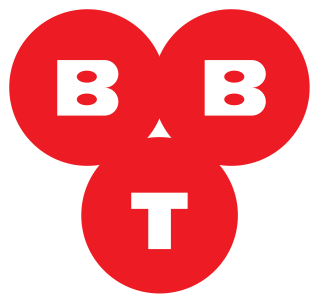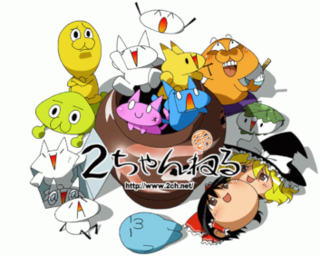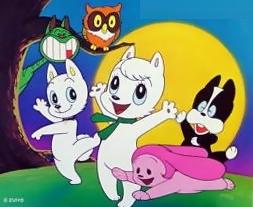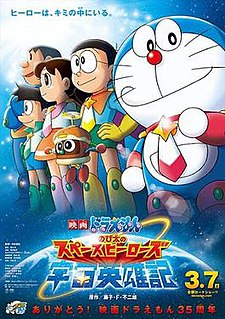| # | Title | Original airdate |
|---|
| 1 | "Doraemon Came Out!!"
"Deta!! Doraemon no Maki"(出た!!ドラえもんの巻) | April 1, 1973 |
|---|
"The Apology Grasshopper Riot"
"Pekopekobatta Ōsōdō no Maki"(ペコペコバッタ大騒動の巻) |
| 2 | "Nice Girl on the Roof"
"Yane no Ue no Sutekina Ko no Maki"(屋根の上のすてきな子の巻) | April 8, 1973 |
|---|
"Nobita's Ancestor"
"Nobita no Gosenzo-san no Maki"(のび太のご先祖さんの巻) |
| 3 | "Understand the Weakness"
"Yowami wo Nigire no Maki"(弱味をにぎれの巻) | April 15, 1973 |
|---|
"Operation Cupid Love-Love"
"Kyūpiddo de Suki-Suki Sakusen no Maki"(キューピッドですきすき作戦の巻) |
| 4 | "There is a Cat Weak on Rats"
"Nezumi ni Yowai Neko mo Aru no Maki"(ねずみに弱い猫もあるの巻) | April 22, 1973 |
|---|
"Defeat the Bully"
"Gakitaishō wo Yattsukero no Maki"(ガキ大将をやっつけろの巻) |
| 5 | "The Flattery Mirror"
"Oseji Kagami no Maki"(おせじ鏡の巻) | April 29, 1973 |
|---|
"Papa and Mama's Wedding Anniversary"
"Papa to Mama no Kekkon Kinenbi no Maki"(パパとママの結婚記念日の巻) |
| 6 | "Cursed Camera"
"Noroi Kamera no Maki"(のろいカメラの巻) | May 6, 1973 |
|---|
"Lottery Jackpot Strategy"
"Takarakuji Ōatari Sakusen no Maki"(宝くじ大当り作戦の巻) |
| 7 | "Duel! Nobita and Gian"
"Kettō! Nobita to Jaian no Maki"(決闘!のび太とジャイアンの巻) | May 13, 1973 |
|---|
"Who am I"
"Watashi wa Daredeshō no Maki"(わたしは誰でしょうの巻) |
| 8 | "Abekonbe Riot"
"Abekonbe Sōdō no Maki"(アベコンベ騒動の巻) | May 20, 1973 |
|---|
"Mystery of the Ghost House"
"Obake Yashiki no Nazo no Maki"(おばけ屋敷の謎の巻) |
| 9 | "The Quick-Slow Great Strategy"
"Kuikku Surō Dai Sakusen no Maki"(クイック・スロー大作戦の巻) | May 27, 1973 |
|---|
"Nobita, the Rain Man"
"Nobita wa Ame Otoko no Maki"(のび太は雨男の巻) |
| 10 | "Ultra Mixer"
"Urutora Mikisā no Maki"(ウルトラミキサーの巻) | June 3, 1973 |
|---|
"Wishing Star, Shooting Star"
"Negai Boshi Nagare Boshi no Maki"(ねがい星流れ星の巻) |
| 11 | "Mysterious Cloth"
"Fushigi na Furoshiki no Maki"(ふしぎなふろしきの巻) | June 10, 1973 |
|---|
"Nobita's Grandma"
"Nobita no Obā-chan no Maki"(のび太のおばあちゃんの巻) |
| 12 | "Red Bat of Major League"
"Dai Rīgu Aka Batto no Maki"(大リーグの赤バットの巻) | June 17, 1973 |
|---|
"To Compete with Man's Power"
"Otoko wa Chikara de Shōbu suru no Maki"(男は力で勝負するの巻) |
| 13 | "Gachako's Appearance"
"Gacha-ko Tōjō no Maki"(ガチャ子登場の巻) | June 24, 1973 |
|---|
"The Talking Lipstick"
"Oshaberi Kuchi Be ni no Maki"(おしゃべり口べにの巻) |
| 14 | "I Love, Love This Camera"
"Sukisuki Kamera no Maki"(すきすきカメラの巻) | July 1, 1973 |
|---|
"Date in the Milky Way"
"Ama no Gawa de Deito Shiyō no Maki"(天の川でデイトしようの巻) |
| 15 | "Weird Robot Car"
"Hen'na Robotto Kā no Maki"(へんなロボットカーの巻) | July 8, 1973 |
|---|
"Smiling Soap"
"Nikoniko Sekken no Maki"(ニコニコせっけんの巻) |
| 16 | "My Chief of the Inner Palace"
"Ore Shochō no Dai Ri no Maki"(おれ署長のだいりの巻) | July 15, 1973 |
|---|
"Now is Summer! Let's Try to Ski"
"Sā Natsu da! Sukī wo Yarō no Maki"(さあ夏だ!スキーをやろうの巻) |
| 17 | "Hate Report Card"
"Seiseki Hyō wa Iya da nā no Maki"(成績表はいやだなあの巻) | July 29, 1973 |
|---|
"Catching My Shadow"
"Jibun no kage wo Tsukamaero no Maki"(自分のかげをつかまえろの巻) |
| 18 | "Going to Sea in a Submarine"
"Sensuikan de Umi Heikō no Maki"(潜水艦で海へ行こうの巻) | August 5, 1973 |
|---|
"Crazy Stomach Clock"
"Kurutta Hara Tokei no Maki"(くるったハラ時計の巻) |
| 19 | "Camp Riot"
"Kyanpu Sōdō no Maki"(キャンプ騒動の巻) | August 12, 1973 |
|---|
"Who is Going to Forget"
"Wasure na Gusa Te Nani Dake no Maki"(忘れな草って何だっけの巻) |
| 20 | "Cooler Parasol"
"Kūrā Parasoru no Maki"(クーラーパラソルの巻) | August 19, 1973 |
|---|
"Always Diary"
"Itsudemo Nikki no Maki"(いつでも日記の巻) |
| 21 | "The Homework Ghost Came Out"
"Shukudai Obake ga Deta no Maki"(宿題おばけが出たの巻) | August 26, 1973 |
|---|
"Weather Box"
"Otenki Bokkusu no Maki"(お天気ボックスの巻) |
| 22 | "I Have One Vote of Betrayal"
"Boku ni Kiyoki Ichi Pyō wo no Maki"(ぼくに清き一票をの巻) | September 2, 1973 |
|---|
"Manga Artist Training"
"Manga Ka Shugyō no Maki"(まんが家修行の巻) |
| 23 | "Nice Girlfriend"
"Sutekina Gārufurendo no Maki"(すてきなガールフレンドの巻) | September 9, 1973 |
|---|
"Flowery Riot"
"Gaippai Sōdō no Maki"(花いっぱい騒動の巻) |
| 24 | "Entirely Crayon"
"Sokkuri Kureyon no Maki"(そっくりクレヨンの巻) | September 16, 1973 |
|---|
"Shizuka's Birthday"
"Shizuka no Tanjōbi no Maki"(静香の誕生日の巻) |
| 25 | "Becoming a Space Astronaut"
"Uchū Hikōshi ni Naritai no Maki"(宇宙飛行士になりたいの巻) | September 23, 1973 |
|---|
"Lost and Confused Riot"
"Maigo Magomago Ōsōdō no Maki"(まいごマゴマゴ大騒動の巻) |
| 26 | "Nendoron Riot"
"Nendoron Ōsōdō no Maki"(ネンドロン大騒動の巻) | September 30, 1973 |
|---|
"Goodbye, Doraemon"
"Sayōnara Doraemon no Maki"(さようならドラえもんの巻) |



